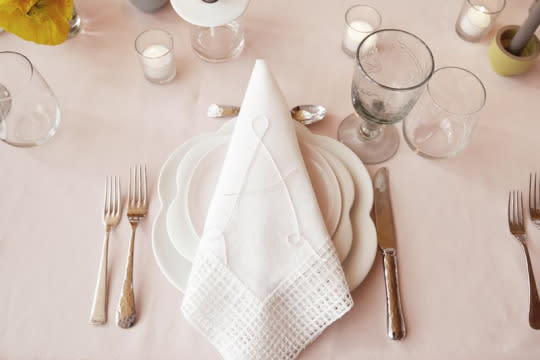Are You For or Against Seating Plans at Dinner Parties?
We’re well into holiday dinner party season and it turns out fighting for space at the bar cart isn’t the only contentious part of the night—Amanda Hesser and I stand divided over whether or not seating plans are a good idea to subject your guests to. (Betcha can’t guess which side I come down on.)
By Lindsay-Jean Hard
Up first, in defense of pick-your-own-seat dinner parties, moi, Lindsay-Jean:

Are you for or against? (Photo: James Ransom/Food52)
Anti-Seating Plans
Holiday dinner parties are hard for introverts.
Don’t get me wrong, I’m not a complete Scrooge—they’re a lot of fun, too. But if you’re an introvert, you’re likely spending time mentally preparing for every social event the holidays inevitably bring, maybe even sneaking away for an extra bathroom break or two to recharge mid-party, and then spending more time decompressing after each fête is over.
Holiday dinner parties mean holiday tablescapes, and because we’re all inclined to make things extra-special this time of year, these tablescapes often include place cards—otherwise known as a cruel and unusual table decor device designed to torture introverts.
Assigned seating sounds good in theory: You get to separate the people who bicker about politics, you get to relegate the duds to the end of the table, and—perhaps most alluringly—you get to make pretty place cards.
Related: How to Navigate Dinner Party Seating Politics

Who should sit next to who? (Photo: James Ransom/Food52)
But when I arrive at a party and I see place cards I immediately start to question whether sweat stains will blend in with the pattern on my party frock and begin a calming internal mantra-cum-pep talk to convince myself that I’ll get through the night unstained, err, unscathed.
I can see how this happens. I bet, if you’re an extroverted host, you are not only excited by the endless DIY place card options, but are genuinely filled with joy at the thought of worlds colliding. You are probably mentally jazzed at all of the introductions that lie ahead, vicariously downright thrilled with all of the new people your friends will get to meet: “Ooh, Larry and Balki should absolutely get to know each other better and I bet Chandler and Janice will really hit it off!”
That’s great—in controlled doses.
If possible, I’m in favor of skipping the seating chart. Just subtly steer more gregarious folk to the center of the table to ensure the conversation will keep flowing and let everyone else fill in as they wish. But if you absolutely must do assigned seating, make buffers for your introverted friends: if you seat a stranger at their left, give them the gift of seating someone they already know well on their right.
Related: How to Seat Guests at a Dinner Party

Seating plans or not? (Photo: Skye McAlpine/Food52)
Pro-Seating Plans
The goal of every host is to come off relaxed, effortlessly whipping up a delicious dinner at a stylishly set table, while casually chatting about the latest book they’ve read. Right? Nothing should seem too organized or overly-wrought, lest you come off as trying too hard. Guests want to feel taken care of, not trapped in your swirl of anxiety. The best dinner parties are those where guests don’t need to make any decisions, and can focus entirely on having a good time.
While we spend 98% of our energy on the lead-up to a dinner party—the cooking, the flowers, the table—we often neglect one of the most important details: how people mix around the table. There’s a foolproof solution that takes 3 minutes to execute. For any dinner with 8 or more guests, make a seating plan. Uptight, you say?
Related: 5 Ideas for Place Cards That You Already Have on Hand

Watch what happens when there’s no seating plan. It’s human nature to cling to what’s easiest, rather than something that might challenge you in an interesting way. People need guidance, otherwise they do things like sit next to their spouse or the person they know best. Think of a seating plan not as an assignment for your guests, but an opportunity for them to have a deeper conversation, a louder laugh, a better time. You arrange them thoughtfully, like you would ingredients, and then mix them up and see where things go.
Have two friends interested in music? Put them next to each other. Have a jokey guest? Put her at the center of the table. Seat yourself near the kitchen. Mix genders, interests, and ages, and if there are more than 12 people, ask people to switch seats for dessert.
If you want to make sure it doesn’t feel formal, ditch the place cards. And then your guests will be doubly impressed that you’ve kept it all in your head.
